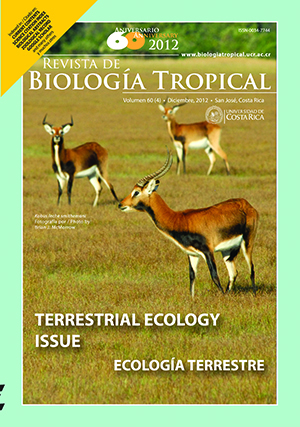Abstract
Population fluctuation of Xyleborus ferrugineus and X. affinis (Coleoptera: Curculionidae) in ecosystems of Tabasco, Mexico. The Scolytinae insects are commonly known as bark or ambrosial beetles because of their feeding habits. Among them, some species restrict their reproductive activity to a host plant or a small number of them, whereas others are highly polyphagous. In order to evaluate the population dynamics of Scolytinae species, populations of Xyleborus ferrugineus and X. affinis in ecosystems from Tabasco, Mexico were studied. The study was carried out from November 2010-July 2011, February 2010-January 2011 and 2007. The trapping methods used were alcohol traps, light traps and direct capture on their host plants. A total of 688 specimens of X. ferrugineus and 3 911 specimens of X. affinis were collected. The population dynamics of X. ferrugineus showed low size population in the studied ecosystems, without any marked seasonality. The high- est population sizes were recorded both in dry season (March-May) and rainy season (September-December). Unlike the populations of X. ferrugineus, those of X. affinis were more abundant and showed the highest peaks during the rainy seasons (except in May at the Botanical Garden “José Narciso Rovisora”). Alcohol and light traps can be complementary methods for monitoring the populations of these types of insects. They occur most of the year and theirs population dynamics depends on food resources availability as well as environmental factors such as temperature and humidity. Judging by the observed abundance it is suggested that X. affinis has been adapted and exploited resources in a better way than X. ferrugineus in those ecosystems. Correlations between abundance and climatic factors had both positive and negative values. The results reflect the behavior of populations. However, a detail assessment of the biological and abiotic factors that influence the fluctuations of these insects is required.Comments
Downloads
Download data is not yet available.






